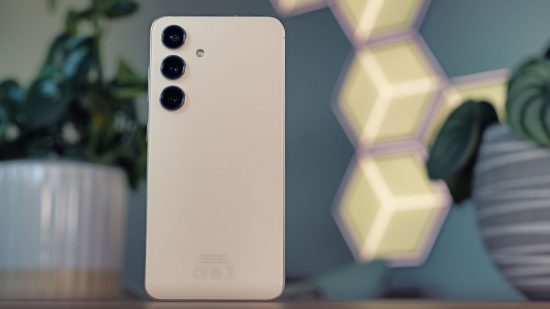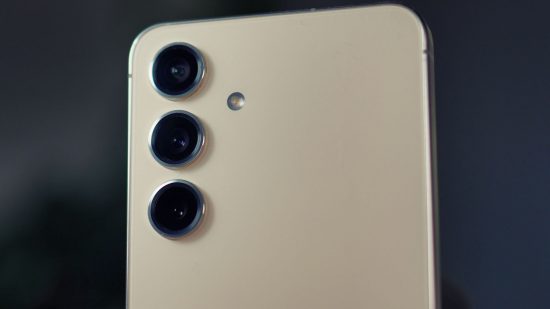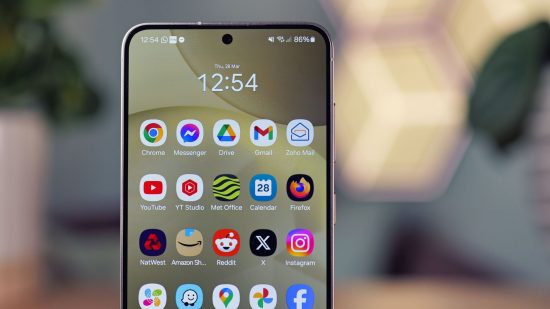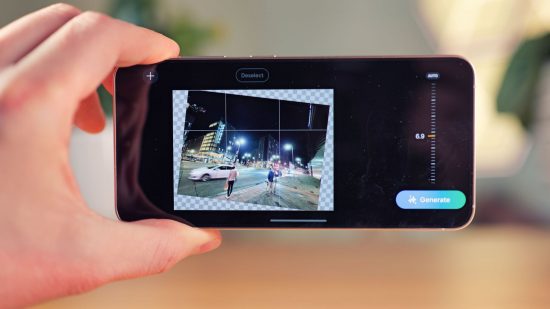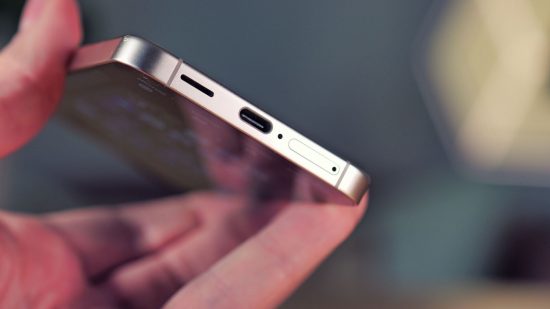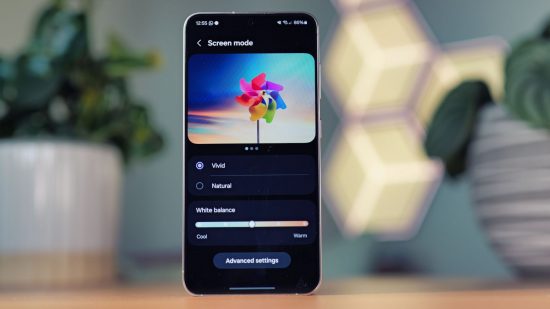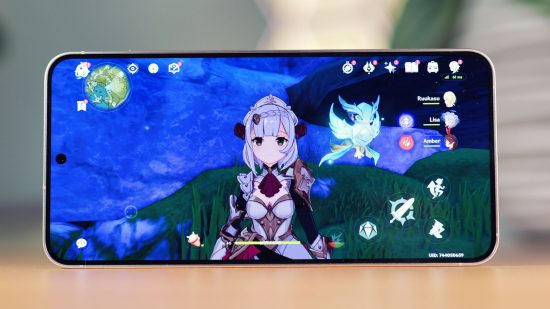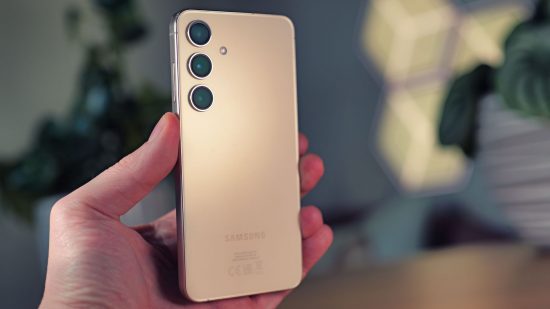Our Verdict
If you like a smaller handset, the Samsung Galaxy S24 is one of the best options on the market. It’s fast, has a great display and takes excellent pictures. However, with very few hardware changes since the previous generation, savvy shoppers might find better value with the S23.
- Small and lightweight
- Powerful performance
- New Galaxy AI features
- Great camera system
- Limited storage options
- Similar hardware to the S23
- Gets pretty warm
- Slow charging speeds
If the features and performance of Samsung’s flagship S24 Ultra appeal to you, but you don’t fancy carrying such a massive (and expensive) slab in your pocket, then the regular Samsung Galaxy S24 might be the perfect phone for you. It offers a lot of the same experience but in a compact and lightweight chassis that’s more convenient to carry.
However, with very few hardware changes compared to the older model, an Exynos processor (in Europe), and limited storage options, can the smallest phone in the S24 lineup deliver like its larger sibling and top pick for our list of the best Samsung phones?
Thankfully, there’s a little more to this phone than first meets the eye. Samsung’s new Galaxy AI features are all present here, the display is better than ever, and subtle improvements to the design make a sizable impact. After using it as my main device for over a week, here’s what I think.
Why you can trust our advice ✔ At Pocket Tactics, our experts spend days testing games, phones, tech, and services. We always share honest opinions to help you buy the best. Find out how we test.
Price and availability
The Samsung S24 launched in late January 2024 and is available to purchase globally, either from Samsung’s website or various third-party resellers, including Amazon.
The base model comes with 128GB of storage and retails for $799.99 / £799, but if you’d prefer 256GB of storage that price increases to $849.99 / £849. If you need more storage than that, you’ll need to look at Samsung’s more expensive S24 models. The S24+ is available with 512GB storage and the Ultra goes up to 1TB.
It’s important to note that in most of the world, the S24 and S24+ utilize Samsung’s own Exynos 2400 processor, but in the US they both run on the Qualcomm Snapdragon 8 Gen 3. Otherwise, the specs remain the same in all regions.
Specs
Features and software
The Samsung Galaxy S24 is absolutely packed with features, basically everything that the Ultra can do, the smaller handset can do as well. It runs Samsung’s One UI 6.1, based on Android 14, and all the fancy new AI-powered features are available on this model, too.
One UI can be a little overwhelming at times, there’s just so much it can do, that you don’t always know where to look. Once you get used to it, though, there are some brilliant features available with this skin. I love how much customization is available for the lock screen and always on display. Samsung is one of the few brands currently supporting lock screen widgets, and they can be really handy. The ability to stack widgets on the home screen and swipe through them is awesome, too. I always miss that when switching to a non-Samsung phone.
As well as being full of features, One UI feels extremely quick. I’m not sure if it’s just the way the animations look, but something about it makes everything feel snappy and responsive. It’s really nice to live with.
I won’t go into too much detail about the Galaxy AI features, as they’re the same on this device as they are on the S24 Ultra. But, to give a quick summary, they’re mostly productivity-focused and work with text and voice. You’ll find translation options, the ability to create summaries and reformat notes, as well as tools to change the tone of your writing. They’re pretty cool and work well, but honestly, I didn’t find myself using them very often.
The one exception is Circle to Search with Google, which is a feature that allows you to circle anything on your screen and instantly Google search for that item. I used this feature a lot, it’s extremely convenient. However, unfortunately for Samsung, it’s not exclusive to the S24 series. It’s already rolling out to Pixel devices, and I bet we’ll see it on other Android phones before too long.
AI tools are available for image editing, too. The S24 gives you the ability to erase unwanted people and objects from your images, remove reflections, and straighten an image without cropping in, as generative AI paints in the corners. You can also turn any video into slow motion by simply long-pressing it as it plays back in the Gallery app.
All the AI stuff is impressive, but many people will be more excited by the long-term software support that Samsung promises. The S24 series gets seven years of OS upgrades and seven years of security patches, so in theory, you could keep this phone for a very long time. This length of support is only matched by the Google Pixel 8 devices, and most other competitors aren’t coming anywhere close.
Design
The Samsung Galaxy S24 has a very similar look to the S23, and, at a glance, you might struggle to tell them apart. However, when you look a little closer, there are some key differences.
The most impactful change, in my opinion, is the new matte finish on both the rear and sides of the device. It’s much more resistant to fingerprints and smudges, which means it looks nicer in use and it’s also quite grippy. This is great if you like to use your phone without a case, as many phones, even matte-finish ones, can be extremely slippery.
The sides are now completely flat, whereas there was a slight curve to the frame of the S23. It’s not a massive difference, but it gives the phone a more boxy, iPhone-like aesthetic, and I prefer it. The corners still have a nice radius, so it always feels comfortable in the hand, and it won’t poke at your palms like the sharp corners of the S24 Ultra might.
Samsung says it has strengthened the Armor Aluminium frame and it’s now 17% more damage-resistant. I’ll have to take their word for it, but to be honest, I’m not that concerned about frame strength, there are much more fragile parts on a phone, like the glass front and rear, for instance.
The device is slightly larger than its predecessor, but we’re talking a couple of millimeters here, and it’s not something you’re likely to notice too much. It’s still a very compact phone, by modern standards. After testing several super-sized flagship phones, it was very refreshing to carry something so small and light. I could barely feel it in my pocket.
Display
Samsung has upgraded the display of the Galaxy S24 this year, it’s now an LTPO panel, and it’s also brighter. This means it can dynamically adjust its refresh rate from 1Hz to 120Hz to match what’s on screen. In essence, it’ll look extremely smooth during fast-paced scrolling and gaming, but it’ll conserve battery life while displaying static imagery.
The panel now tops out at 2600 nits peak brightness, a vast increase over the 1750 nits of the previous generation. Theoretical numbers aside, the screen gets plenty bright enough for my needs, and the early spring sunshine never posed a threat to this dazzling panel. HDR content also looks excellent on this screen, with dark detailed blacks and beaming highlights. What I really missed, compared to the S24 Ultra, was the excellent anti-reflective coating. I’ve got my fingers crossed for Samsung to bring it to more models next year.
Given that this is a smaller phone, it doesn’t have the largest display, but the bezels are almost unnoticeable on this model, so it makes the most of the available space. In day-to-day use, I never found it to feel too small, even when watching full-screen YouTube content, and it’s nice to be able to reach the top of the display without straining too much. For gaming, though, I could use a bit of extra space, FPS games like CoD Mobile and PUBG felt particularly cramped while testing.
The S24 has a lower resolution panel than its larger siblings, it’s only FHD+, compared to QHD+ on the S24+ and Ultra. In use, though, I never found it to be an issue. It’s a perfectly decent pixel density for a display of this size, and everything always looks sharp and detailed. The colors look superb straight out of the box, but you’re also given some tools to tweak the color balance if you prefer.
The S24 comes with dual stereo speakers, and the sound quality is above average. A little more bass wouldn’t go amiss, but it’s a pleasant sound with lots of detail and good staging. I rarely muffled the speakers with my hand in use, either – something that was a constant struggle with the S24 Ultra.
Cameras
The camera specifications for the Samsung Galaxy S24 are identical to those of the S23, so unfortunately, there’s not too much to get excited about here. That said, there are subtle differences in the camera quality compared to last year’s model, mainly due to changes in Samsung’s image processing.
I found that photos from the Galaxy S24 had a bit of a more natural tone, with less exaggeration in the colors of the sky and grass. The sharpening seems less aggressive overall, too. It’s a subtle change, one that you could mostly replicate with quick image edits, but it’s still a change for the better.
The spec sheet might not wow with high-megapixel counts and large sensors, but the important thing is that the S24 is capable of taking some great photos. As usual, the main camera is the best one, it captures the finest details and excels in low-light shooting, where the other two begin to struggle.
That said, the ultrawide and 3x telephoto are both very useful focal lengths. I particularly enjoyed using the 3x lens to capture portraits and macro details, while the ultrawide is essential for landscapes and architecture. I can’t help but wish the ultrawide had autofocus, though. It’s fixed at infinity, so you can’t use it for any close-up shooting.
The selfie camera, on the other hand, has autofocus, and that means it always looks sharp no matter whether you’re shooting a large group of people or using tight framing for a moody headshot. The portrait mode works excellently, too, and combined with a plethora of beautification options and filters, the S24 can deliver some very flattering self-portraits.
In video mode, you can shoot at up to 8K 30fps, but the file sizes are massive, and with 256GB being the maximum storage capacity, you’re better off sticking to 4K. Videos from the S24 look great. The stabilization is solid, and the microphones are better than most competitors, so videos sound as good as they look.
I was really pleased to see that the 4K 120fps slow-motion shooting capabilities of the S24 Ultra have trickled down to the smaller model. It’s a big step up in quality compared to the 1080p slow-mo modes available on most other flagships. Of course, with the power of AI, this phone can turn any clip into slow motion regardless of the frame rate. It’s a pretty cool feature, but weird artifacts always appear when using it. Nothing comes close to real 120fps footage, in my eyes.
Performance
My test sample is the European base model, which means Samsung’s Exynos 2400 processor powers it, and the handset comes with 8GB of RAM and 128GB of storage. These days, there are plenty of mid-range phones that come with 256GB storage as standard, some of which cost half as much as the S24, so the lack of storage options here is very disappointing.
I could happily live with 8GB of RAM, this phone still multitasks like a champ, but the storage situation is very limiting. Genshin Impact alone takes up over 30GB of space, and when you only have 128GB to work with, you’re likely to hit that limit much sooner than you’d like. Samsung has reserved higher storage capacities for its larger phones, and I think that’s a misstep. It’s possible to prefer a smaller handset and still be a power user.
I was also a little nervous about the move to Samsung’s Exynos 2400 processor, but I shouldn’t have been, because it hangs with the best of them. Qualcomm’s Snapdragon 8 Gen 3 is a little better in graphics benchmarks, but in reality, you’d have a hard time telling them apart. The phone consistently felt lightning-quick and highly responsive no matter what I was doing.
I was able to max out the settings in Genshin Impact and play at a stable 60fps, which is one of the most demanding tasks you can ask of a phone. Doing this makes the phone pretty warm after 15 minutes or so, but in fairness, that happens with the Snapdragon-powered Ultra, too. In my experience, the screen size is more of a limiting factor for gaming than the processor, but those with more petite fingers will probably feel differently.
Battery
The Samsung Galaxy S24 has a slightly smaller 4000 mAh battery pack, while most flagships hover around the 5000 mAh mark. It’s understandable, given its physical size, but I was still apprehensive about whether it would see me through the day. Again, it turns out I needn’t have been, because the Galaxy S24 saw me through an average day’s use with ease.
Of course, it’s possible to run out of juice before bedtime, especially if you’re doing a lot of gaming or taking lots of photos, but even on days with extremely heavy usage, the S24 made it well into the evening, and by that point, there’s usually a charger nearby.
There’s no wall adapter included in the box, you only get a USB-C cable, as is the case with most Samsung phones. It’s also the slowest charging phone I’ve used recently, topping out at just 25W. It’s not awful, you can still get a full charge in just over an hour with the appropriate charger, but it’s a little jarring if you’re used to the 100W+ speeds you get with many Chinese flagship phones.
The S24 also supports wireless charging, but that’s slower still, with just 15W charging supported. It won’t be the method of choice if you’re in a hurry, but if you’ll be at your desk for a long time, or have a charger in the bedroom, it’s very convenient to just chuck the S24 on a charging pad and let it slowly juice back up.
Should you buy the Samsung Galaxy S24?
The Samsung Galaxy S24 has only received minor upgrades compared to last year’s Galaxy S23, and because of that, I think the older model is its biggest competitor. To summarise the changes, the S24 gets a design refresh with matte textures and flat edges, a brighter, larger LTPO display, and the new Exynos (or Snapdragon) chipset. It’s a bit faster, and I prefer the new look, but the two phones aren’t worlds apart.
The new Galaxy AI features were a unique selling point at launch, but they’re already rolling out to S23 devices via a software update, so that doesn’t factor in as much as it could. Elsewhere, you’re in for a very similar experience, meaning the S23 seems like the better deal, for now.
That said, the Galaxy S24 is still an excellent phone in its own right, and if you prefer a smaller handset, and see a good price, then it’s an excellent choice. When the S23 stock dries up, the S24 is sure to live on as one of the best compact phones around. Until the S25 comes along, anyway.
Alternatives
If you’re not sure that the Samsung Galaxy S24 is right for you, here are a couple of other excellent compact flagships to look at.
Xiaomi 14
This is another compact Android phone with flagship-level specs. It’s a little larger, and a bit pricier, but it benefits from a triple 50MP camera array, a Snapdragon 8 Gen 3 processor, blazing fast charging, and up to 1TB of storage. The downside is that the software isn’t as refined, there’s less AI, and you won’t get the same long-term software support as the S24. If it sounds like the one for you, check out our full Xiaomi 14 review.
iPhone 15
If you’re open to the idea of an iOS device, the iPhone 15 is another excellent flagship phone in a similarly small package. The cameras are solid, the performance is great, and there are plenty of exclusive games available on Apple’s platform. If you don’t mind wielding something a little larger, then it’s well worth also checking out our iPhone 15 Pro Max review.
